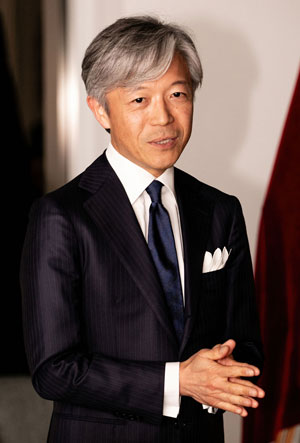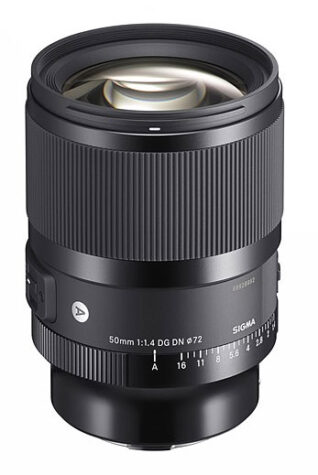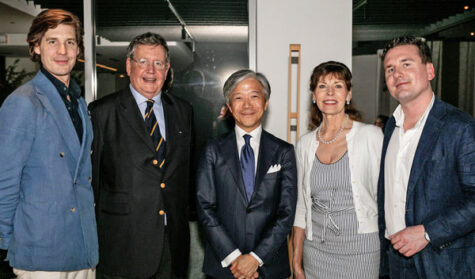Nine years ago when Inside Imaging initially interviewed Sigma CEO Kazuto Yamaki, the specialist lens maker had recently released the first of its ‘Art’ series of affordable premium lenses. This was a game-changing initiative which gave access to high quality optics to a significantly expanded number of photographers around the world.

Up until then premium lenses were, with few exceptions, the domain of the camera manufacturers. Sigma came in with high quality, wide-aperture prime lenses at a half, sometimes a third of the price of the Canon and Nikon equivalents.
‘I’m very happy with what we have achieved in these 10 years,’ said Mr Yamaki. ‘Especially the introduction of our Art series. We have had a great impact in the industry.
‘The Art series has much higher performance than existed, but with a lower price. So many companies look to Sigma as the benchmark in optical quality, and they are working very hard to make very good optics. So I think we have influenced the industry a lot. We have lifted the standard.’
He refers here not only to the camera makers’ ranges, but competing third party lens manufacturers. For instance, nearest competitor Tamron now offers its own premium SP (Superior Performance) range.
If basic supply and demand economics actually work, Sigma’s successful entry into the premium end of the lens market should have another positive impact – putting downward pressure on the competing optics from the likes of Canon and Nikon and Sony (let alone L-mount partners Panasonic and Leica). Mr Yamaki suggested the larger operators were constrained by a higher cost base.
‘Hand-made’ lenses
‘It costs a lot to make very good optics, so even if they wanted to put a better price on their products, I’m sure it’s quite difficult for them to do so as the companies are so big.

‘It’s quite difficult even for us to keep costs down,’ he explained. ‘We invested heavily in the factory these 10 years, but still we can’t increase the volume of production as it takes more and more time to make one good lens.
‘We spend more time to polish the glass and assemble the lenses compared to the process 10 years ago. In order to make very good optics we have to check every detail and we have to make all the parts with very high tolerances. It takes more time, which pushes up production costs.’
But does ever-increasing lens performance matter so much any more, with computational photography enabling even camera phone lenses to deliver quality which would have been seen as astounding a few short years ago?
In an interview with DP Review earlier this year Mr Yamaki noted: ‘The image quality from smartphones has improved drastically over the past several years, mainly due to computational photography. I’m amazed. This might change imaging technology.’
We asked whether this was a threat to the kind of fine optics manufactured by Sigma.
‘No,’ he said. ‘In order to capture very fine micro-details you need to have the best optics. Even though computational photography is so powerful and works very well, it can’t create detail. Having good optics is still important. Computational photography can go some way to making better detail, but still it can’t beat very fine optics.’
One of the features of Sigma’s latest Art lenses for (some!) mirrorless cameras is that they are considerably lighter than the first Art primes, which along with high quality performance were characterised by bulk and weight. We asked whether the lightweight form factor of the new range is was due to mirrorless mounts or R&D developments at Sigma.
‘Both. The short flange back on mirorless cameras makes it easier to make lenses which are smaller and lighter. Especially for wide angle lenses. For wide end primes and zooms especially mirrorless mount are very helpful for us. But new technology has also helped.’
And while the new lenses may be lighter, they are no less complex. ‘The number of elements per lens is still increasing but thanks to technology like aspherical elements we can make them small and light. And the more elements, the more costs. We also try to make each lens as thin as possible.’
Are all mirrorless mounts equal?
‘I think the L-mount is superior to other mirrorless mounts. Customers can use a wider variety of products from Sigma, Leica and Panasonic. And now DJI. It offers a unique choice of options.’
‘I don’t think there’s a significant difference technically compared to other mounts. There’s a small benefit in that the mount diameter is not too big and not too small. From an optical design point of view the Sony E-mount is a bit too small to make the lens for a full frame sensor. Nikon Z is good for making good optics.
‘When it comes to the lens mount the bigger the better, technically, but if we make a small compact lens it doesn’t look great because the lens mount is bigger than the lens diameter.’
As followers of the ‘lens wars’ will know, there have been varying degrees of reluctance from the camera makers in sharing their technology with third party manufacturers (and competitors) such as Sigma, with Sony the most open and Canon keen to keep a closed system going when it comes to its RF lenses.
‘I hope the situation will change,’ said Mr Yamaki. ‘I know that customers are eagerly waiting for RF-mount from Sigma, and I think its good for customers.
‘It would be a great customer benefit if we could supply RF-mount lenses. We will do our best.’
One challenge currently confounding Sigma is manufacturing lenses for the cinematography market. Here’s a visual art which prizes imperfection! But building lenses with deliberate aberrations or other optical quirks goes against the grain at Sigma.
‘In still photography there’s not a big demand for “lenses with character” because if you make a big print the “character” result may disappoint photographers. When it comes to stills the majority wants even higher resolution, higher detail.
‘But in film they need lenses with character. It’s a bit confusing trying to understand the needs of cinematographers. They require imperfection, so its confusing. For example, a football player practices every day. But working with imperfection – it’s like asking him to miss a goal!’
Unique and innovative cameras and lenses

He said that the factory was back on track after Covid disruptions, and that the localised supply chain Sigma uses had worked in its favour with the world in turmoil.
‘We didn’t have to lay off employees and actually we worked very hard. We make everything in Japan and most of our suppliers are like us in North Japan. Compared to large companies our supply chain network is quite small, and that’s why we could continue the operation.
He added that during Covid, the one component Sigma did import, semi-conductors, at some stages went from the list price of around 50 cents to $15, and stayed like that for months.
Mr Yamaki said we can expect innovation on both the lens and camera fronts from Sigma this year
‘We will release some very unique, innovative products,’ he told us. ‘Up until now we have had to focus on standard, regular products for mirrorless cameras. Moving forward we will release some unique and innovative lenses.
Innovative lenses, eh? Perhaps Sigma might venture into mirror (catadioptric) lenses, which seem to be making a comeback? ‘If there is demand we are happy to do that. Some fashion photographers like to use mirror lenses for their unique ring bokeh. It’s due to the structure of the lens. So you will see the ring bokeh behind the subject which makes the image look unique. Some fashion photographers like that, but so far there’s not a lot of demand.
So we’ll have to wait for for more on Sigma’s ‘unique and innovative’ lens offerings. Mr Yamaki remained quiet on details.
– And likewise on camera developments, except to say that 75 percent of Sigma employees were engineers, with two separate development teams. Team One is always working on cameras and ‘Team One is now working on the future camera.’
Australian and NZ Sigma customers will be pleased to know the local distribution arrangement is rock solid.
‘Sigma is performing very well in the local market. We have done business with CR Kennedy 33 years. We have had good times and bad times but they have been a consistent support to us, so we are 100 percent happy.
‘CR Kennedy is one of our best distributors, actively developing new sales and marketing activities. We are very impressed.’





Be First to Comment